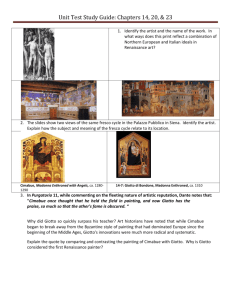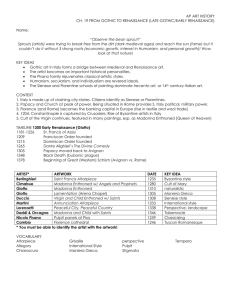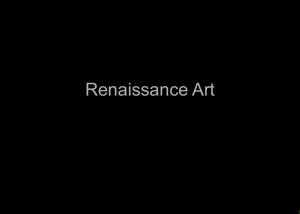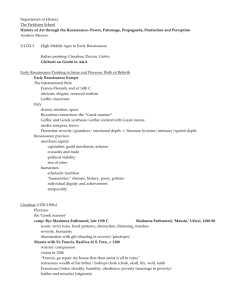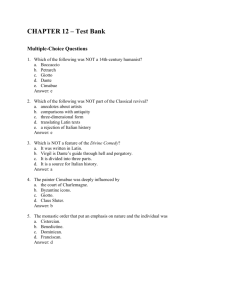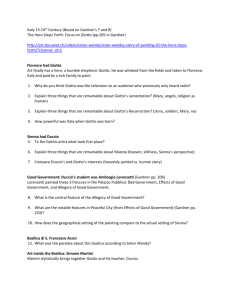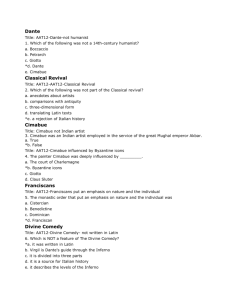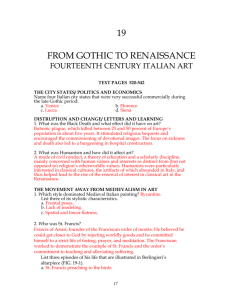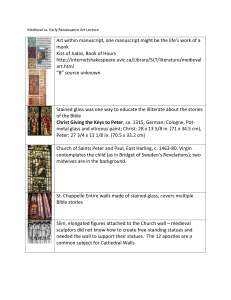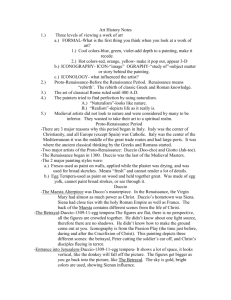Ch 19 AP Study Guide..
advertisement
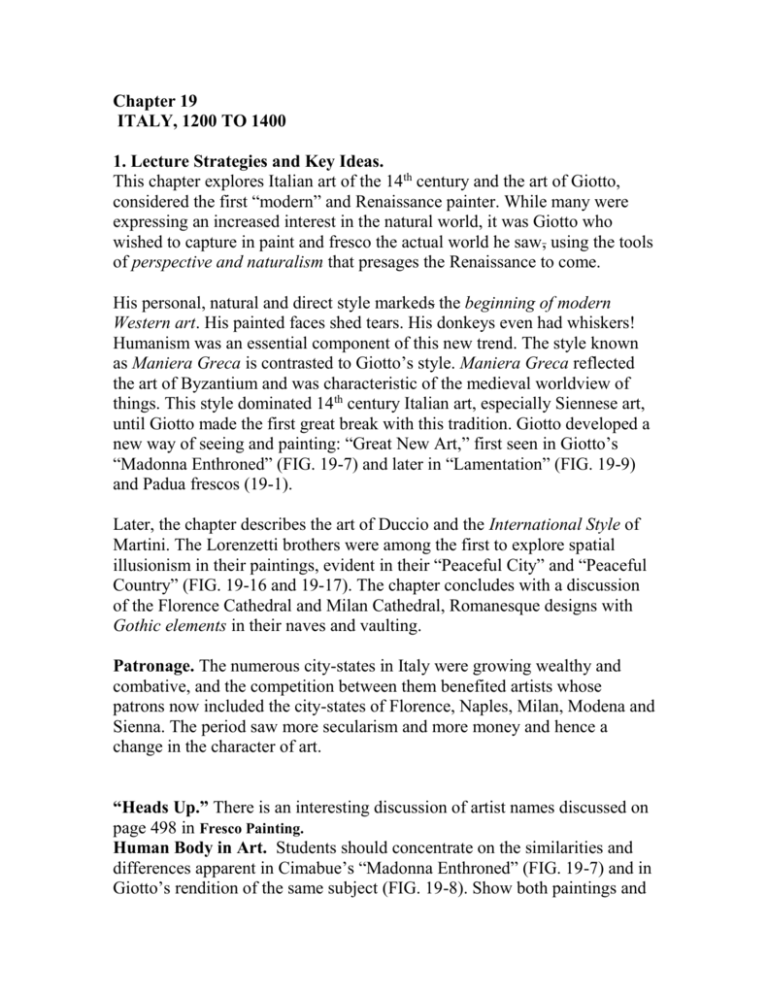
Chapter 19 ITALY, 1200 TO 1400 1. Lecture Strategies and Key Ideas. This chapter explores Italian art of the 14th century and the art of Giotto, considered the first “modern” and Renaissance painter. While many were expressing an increased interest in the natural world, it was Giotto who wished to capture in paint and fresco the actual world he saw, using the tools of perspective and naturalism that presages the Renaissance to come. His personal, natural and direct style markeds the beginning of modern Western art. His painted faces shed tears. His donkeys even had whiskers! Humanism was an essential component of this new trend. The style known as Maniera Greca is contrasted to Giotto’s style. Maniera Greca reflected the art of Byzantium and was characteristic of the medieval worldview of things. This style dominated 14th century Italian art, especially Siennese art, until Giotto made the first great break with this tradition. Giotto developed a new way of seeing and painting: “Great New Art,” first seen in Giotto’s “Madonna Enthroned” (FIG. 19-7) and later in “Lamentation” (FIG. 19-9) and Padua frescos (19-1). Later, the chapter describes the art of Duccio and the International Style of Martini. The Lorenzetti brothers were among the first to explore spatial illusionism in their paintings, evident in their “Peaceful City” and “Peaceful Country” (FIG. 19-16 and 19-17). The chapter concludes with a discussion of the Florence Cathedral and Milan Cathedral, Romanesque designs with Gothic elements in their naves and vaulting. Patronage. The numerous city-states in Italy were growing wealthy and combative, and the competition between them benefited artists whose patrons now included the city-states of Florence, Naples, Milan, Modena and Sienna. The period saw more secularism and more money and hence a change in the character of art. “Heads Up.” There is an interesting discussion of artist names discussed on page 498 in Fresco Painting. Human Body in Art. Students should concentrate on the similarities and differences apparent in Cimabue’s “Madonna Enthroned” (FIG. 19-7) and in Giotto’s rendition of the same subject (FIG. 19-8). Show both paintings and let the new art of Giotto “sink in” for students. They should identify Madonna as a “living” human being with human characteristics as opposed to the static Madonna of Cimabue. Cimabue painted the concept of a Madonna while Giotto painted her full and expressive human body. (Teachers, be careful not to give the impression that Giotto’s style is better that Maniera Greca, only different, and was the result of a host of influences and Giotto’s individual genius.) Narrative in Art. Have students explain the story being told by Giotto’s “Lamentation” (FIG. 19-9) and explore how he used a “stage” in which to show the story. The figures appear as a still life, each reflecting a different emotion as they view the body of Christ. Even the little floating angels agonize. 2. Key Vocabulary. Maniera Greca Pulpit Lamentation Chiaroscuro perspective Duccio Lorenzetti Brothers stigmata Cimabue grisaille Saint Francis Giotto’s Great New Style fresco painting “Mary in Majesty” International Style Martini plague 3. Key Images from Gardner’s Art Through the Ages Artist Maniera Greca Nicolo Pisano Giovanni Pisano Cimabue Giotto Giotto Giotto Duccio Martini Lorenzetti Gardner FIG. Number 19-1 19-2 19-4 19-7 19-8 19-1 19-9 19-10 19-13 19-16/17 Cambio Venice 19-18 19-21 Subject Saint Francis Pulpit at Pisa Pulpit Madonna Madonna Arena Chapel Lamentation Virgin and Child Annunciation City and Country Key Idea Byzantine style Classicizing Gothic dynamics Maniera Greca Great New Style New naturalism Giotto’s humanism Siena style International Style Perspective, landscape, allegory Florence Cathedral Italy 14th century Doge’s Palace Italian Gothic 4. Websites. A good source of online websites that contains images for all Art History, including pre-historic art, is found at http://www.art-design.umich.edu/mother/ Fine close-up images of Cimabue’s art at http://www.christusrex.org/www2/art/Cimabue.htm For more on Giotto and the Arena Chapel and its recent restoration see http://news.bbc.co.uk/1/hi/world/europe/1769744.stm Several “Quick Time Virtual Reality” tours of Florence’s Cathedral are at http://www.fullscreenqtvr.com/firenze_cattedrale/ 5. Questions: Each chapter of Gardner’s Art Through the Ages textbook has a corresponding quiz and test in the “Instructor’s Manual.” The CDROM allows teachers to choose which questions to use and to create and print quizzes and tests. Essay Questions. 1. Show: Giotto, Arena Chapel (frescos, 1305) FIG 19-1 and Giotto, Lamentation fresco from the Arena Chapel (fresco, 1305) FIG. 19-9. Question: Identify the artist responsible for the decoration of this chapel. What innovations in painting did he undertake that challenged the current style of his time? (8 minutes.) Students should recognize the work of Giotto and discuss his new naturalism, softness, details and emotionalism and see how it contrasts with the Byzantine-inspired Maniera Greca of his contemporaries. 2. Show Cimabue’s “Madonna Enthroned” (FIG. 19-7) and Giotto’s “Madonna Enthroned.” (FIG. 19-8). Question. Which of these two paintings is in the style of Maniera Greca and which is by Giotto? What characterizes Giotto’s painting from the other? Students should explain that Giotto’s Madonna (FIG. 19-8) is a “living” naturalistic human being, with personalized characteristics and expression, as opposed to the more static Madonna of Cimabue. Cimabue painted the concept of a Madonna while Giotto painted an actual full and expressive human being.
